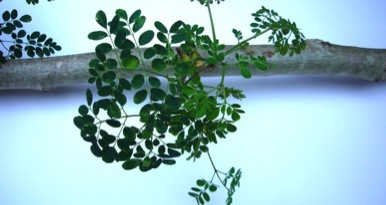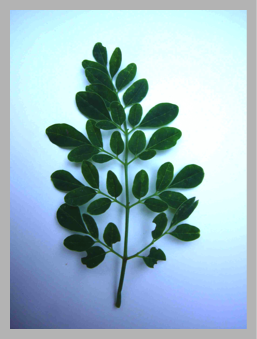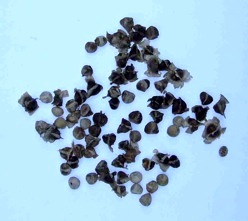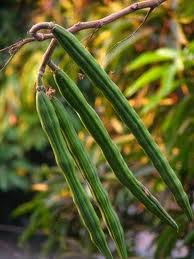Moringa oleifera ….Monster…. Almost
If you have a warm back yard, think twice before you plant a Moringa tree.
Is it edible? Yes, most of it. Is it nutritious? Amazingly so, flowers, seeds and leaves. Does it have medical applications? Absolutely, saving lives on a daily basis. Can it rescue millions from starvation? Yes, many times yes. So, what’s the down side? They don’t tell you that under good conditions it grows incredibly fast and large, overwhelming what ever space you allot to it. It can grow to monster proportions in one season.
I live in central Florida exactly — and I mean exactly — on the line between temperate and subtropical. I have not experienced a hard freeze here in seven years probably because I sit on a hill and have a 30,000 gallon pool to moderate temperatures. Around year two I got two food trees, Katuk and Moringa. You can read about the Katuk in another article.
It is an understatement to say the Moringa grows more than 10 feet a year. I have two trees and every year I cut off 15- to 20-foot branches. It requires constant attention. Despite its impressive growth pattern, it’s an extremely brittle tree. A man can easily break off a branch four inches through,…. It’s nice to feel like Hercules now and then.
The easy-breaking branches also lend themselves to a common-heard phrase in India when someone is being a little too demanding: “Don’t push me up a Moringa tree.” But, I will admit both trees withstood 100 mph winds three times in the hurricanes of 2004.
I want to impress upon you that my reference as to how fast this tree grows is a gross understatement, no matter how overstated it might seem. While gigantic growth is great for hungry poor countries, it is a significant headache for a suburban yard, even a 40-acre ranch. Unattended, the tree grows into a spindly giant. If you don’t attend it twice a month you will have a monster on your property, and I have two of them, one self-seeded. Should you choose to grow it, just know what you are getting in for. Now days I cut both trees back to a three foot stump every spring, the same as where they are cultivated. These things grow so fast, I speculate you could get a crop of leaves off them in Northern Canada. Then over winter it inside. It might make a real nice potted, pruned indoor tree for northern climes. That said, let’s view the virtues of the Moringa.
This tree is one of the world’s most useful plants. A native to the southern foothills of the Himalayas, Moringa oleifera (mo-RIN-ga oh-lee-IF-er-uh) is cultivated around earth’s tropical belt. Moringa is grown for its leaves, fruits, seed, sap and roots. It provides a variety of food and medicine. The young fruits pods, called drumsticks, can be cooked many ways, often like green beans, and have an asparagus taste. A superior cooking oil comes from the seeds, and the light oil can be used to lubricate delicate mechanisms. The leaves are extensively used as a vegetable — I have a restaurant-owning Chinese friend who makes a great soup out of them — and the roots are made into a condiment resembling horseradish in taste, but use it sparingly for it contains an alkaloid, spirochin. A blue dye can be made from its sap. Even a health drink is made from the tree. M. oleifera also might have a great future in water purification, a prime cause of illness in the world. And that is just the start of the amazing overgrown weed called “The Miracle Tree.”
There is only one family of Moringa trees, and only 13 members, making it one of the smallest groups. Of all 13, M. oleifera is the one most cultivated and usually the one referred to when talking about the edible Moringa. The name Moringa comes from the Tamil/Malayalam word murungakka. A search using “murungakkai” will produce many recipes. Oleifera means oil bearing. In the Philippines it is called “mother’s best friend,” in Florida, “the horseradish tree,” and in India “the drumstick tree.” In India it is an absolute must-have plant in the kitchen garden. In Thialand they are used as living fences.
From a food point of view, Moringa leaves can be used like spinach, though they are far more nutritious. Sorry Popeye. The leaves can be used fresh or dried into a powder. The leaves are an excellent source of vitamin A and C, a good source of B vitamins, and among the best plant sources of minerals. The calcium content is very high, iron is good enough to treat anemia — three times that of spinach — and it’s an excellent source of protein while being low on fats and carbohydrates. Said another way, Moringa leaves have seven times the Vitamin C of oranges, four times the calcium of milk, four times the vitamin A of carrots, three times the potassium of bananas, and two times the protein of yogurt. That’s quite a line up. The leaves also have the sulfur-containing amino acids methionine and cystine. Medically it is antibiotic and research shows it can be used to treat high blood pressure. A leaf tea is used by diabetics to help regulate their blood sugar. It is full of antioxidants, is anti-cancerous, and when eaten by mothers they give birth to healthier, heavier babies. A 28 December 2007 study said a root extract is very anti inflammatory.
In fact, let me quote you an earlier abstract from Phytotherapy Research 16 Sept 2006:
Moringa oleifera Lam (Moringaceae) is a highly valued plant, distributed in many countries of the tropics and subtropics. It has an impressive range of medicinal uses with high nutritional value. Different parts of this plant contain a profile of important minerals, and are a good source of protein, vitamins, -carotene, amino acids and various phenolics. The Moringa plant provides a rich and rare combination of zeatin, quercetin, -sitosterol, caffeoylquinic acid and kaempferol. In addition to its compelling water purifying powers and high nutritional value, M. oleifera is very important for its medicinal value. Various parts of this plant such as the leaves, roots, seed, bark, fruit, flowers and immature pods act as cardiac and circulatory stimulants, possess antitumor, antipyretic, antiepileptic, antiinflammatory, antiulcer, antispasmodic, diuretic, antihypertensive, cholesterol lowering, antioxidant, antidiabetic, hepatoprotective, antibacterial and antifungal activities, and are being employed for the treatment of different ailments in the indigenous system of medicine, particularly in South Asia. This review focuses on the detailed phytochemical composition, medicinal uses, along with pharmacological properties of different parts of this multipurpose tree. Copyright © 2006 John Wiley & Sons, Ltd.
Now you know why they call it “The Miracle Tree.” It is being planted extensively in poorer areas of the world, some 400,000 trees in Rwanda alone.
To cultivate, soak the seeds for a day in water, plant in a peat pot. When six inches high, put in fertilized ground, and stand back! When it is six feet high cut the top off, forcing side shoots. Hang the top upside down in the shade and let it dry. Then grind the leaves into powder.
Today, approaching Valentines Day, I did my annual Moringa cut back. It takes about four hours, not counting nibbling and seed saving. Every year I promise myself I will trim them more often and every year they rocket to the sky. But that’s really not a problem. I just climb on the roof and collect dinner.
Green Deane’s “Itemized” Plant Profile
IDENTIFICATION: Slender tree, to about 35 feet; drooping branches, brittle stems, corky bark; leaves feathery, pale green, compound, tripinnate; flowers fragrant, white or creamy-white, in sprays, 5 at the top of the flower; stamens yellow; pods pendulous, brown, triangular, splitting lengthwise into 3 parts when dry, containing about 20 seeds, pod tapering at both ends, 9-ribbed; seeds dark brown, with three papery wings.
TIME OF YEAR: In zone nine Florida, it leaves most of the year, with seed pods in the late spring and summer.
ENVIRONMENT: Originally from India, planted in frost free areas around the world. Naturalized in many areas. Grows best in sand soil, tolerates poor soil. It loves sun and heat and can be grown from seed.
METHOD OF PREPARATION: Leave can be eaten raw or cooked like spinach, young seed pods can be cooked many ways, seeds are edible, cooked flowers taste like mushrooms, and the roots can be made into an occasional condiment.





